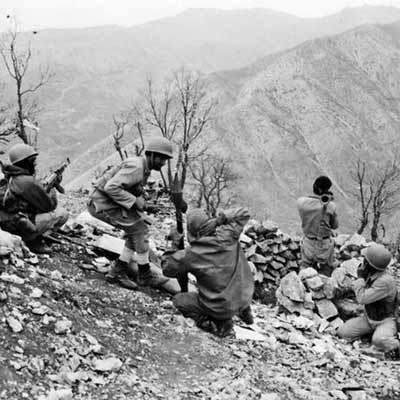Battles
Operation Nasr 9
Zeinab Ahmadi
157 Views
On November 22, 1987, the Islamic Republic of Iran Army Ground Forces launched Operation Nasr 9 in the Haj Omran region to liberate the occupied areas and capture some strategic mountains.
Haj Omran, a city in Erbil Province within the Kurdistan region of Iraq, is located on the Iran-Iraq border west of Piranshahr County (West Azerbaijan Province, Iran). Since Operation Valfajr 2 (July 20 – August 3, 1983) and the capture of key heights in that area by Iranian forces, the Iraqis have been carrying out periodic assaults to retake these strategic positions.
On November 22, 1987, the 64th Urmia Division of the Iranian Army Ground Forces, accompanied by a commando battalion from the 25th Commando Brigade, launched Operation Nasr 9. Carried out under the code-name “Ya Molay-e Motaqiyan (as)”, the operation aimed to liberate the southern slopes of the Gardmand Heights (Peak 2519 in the Haj Omran), also known as Shuhada Hill and destroy the Iraqi units and that of People’s Mojahedin Organization (Munafiqeen). The battle lasted three days.[1]
Initially, the Iranian forces successfully captured peaks 2080, 2060, 1980, and 1985, liberating approximately 12 square kilometers of occupied territories. Then, the Munafiqeen units, while wearing military uniforms and carrying flags inscribed with “La Ilaha Illa Allah”, passed through Gardmand Heights and Harana Valley to engage the 64th Division in hand-to-hand combat. However, under heavy Iranian artillery fire, they lost 80 soldiers and were forced to retreat.[2]
In the initial attack, the Shuhada Hill was seized by the Iranians. However, due to intense Iraqi counterattacks and Iranian troops suffering from physical and mental fatigue, the liberated positions were eventually recaptured by the enemy.[3]
Iranian forces then launched an assault on Iraqi troops stationed in the Haj Omran Heights, successfully defeating Iraq’s 3rd Battalion of the 433rd Brigade of the 23rd Division. The 1st and 2nd battalions of this brigade also lost 70% of their equipment. Moreover, two mortar firebases (120 mm) and a 130 mm artillery base of Iraq’s 909th Artillery Battalion were destroyed.[4]
The enemy’s losses in this operation included the destruction of 10 ammunition depots, 40 vehicles, 5 tanks, 19 artillery pieces, 10 mortars, and more than 450 light weapons. Furthermore, 1200 Iraqi soldiers and 150 Munafiqeen members were killed, while 100 others were taken prisoners. A large number of light and heavy weapons, communication equipment, and various types of ammunition were also seized by Iranian forces.[5]
[1] Atlas-e Nabard-haye Mandegar (Atlas of Enduring Battles), by Mojtaba Jafari, Tehran: Nodid Tarahan, 2004, p. 140; Atlas-e Jang-e Iran va Araq (Atlas of the Iran-Iraq War), by Mohsen Rashid, Tehran: Markaz-e Asnad va Tahqiqat-e Defa-e Muqaddas-e Sepah-e Pasdaran-e Enqelab-e Eslami, 3rd ed., 2013, p. 86.
[2] Rouzshomar-e Jang-e Iran va Araq (Chronology of the Iran-Iraq War), Ketab-e Panjah-o-Dovom: Takapou-ye Jahani baraye Tavaqqof-e Jang (Volume 52: Global Efforts to Stop the War), Tehran: Markaz-e Asnad va Tahqiqat-e Defa-e Muqaddas-e Sepah-e Pasdaran-e Enqelab-e Eslami, Pp. 80, 82.
[3] Atlas-e Nabard-haye Mandegar (Atlas of Enduring Battles), by Mojtaba Jafari, p. 140.
[4] Karnameh-ye Tavsifi-ye Amaliat-haye Hasht Sal-e Defa-e Muqaddas (Descriptive Report of Operations in the Eight-Year Sacred Defense), by Ali Samiei, Tehran: Moavenat-e Tablighat va Entesharat-e Namayandegi-ye Vali-ye Faqih dar Nirou-ye Zamini, 1997, Pp. 364–366.
[5] Ibid.





